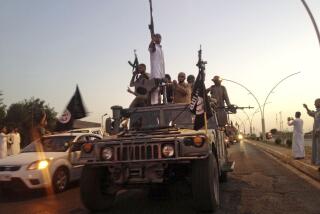Senior Islamic State leader has died, according to reports
- Share via
Reporting from Baghdad — Top Islamic State commander and feared Chechen jihadi fighter Omar Shishani has died of wounds suffered in a U.S. airstrike in Syria last week, a senior Iraqi intelligence official and the head of a Syrian activist group said Tuesday.
Shishani died Monday outside the Islamic State group’s main stronghold of Raqqa in Syria, the two told the Associated Press.
NEWSLETTER: Get the day’s top headlines from Times Editor Davan Maharaj >>
The red-bearded ethnic Chechen was one of the most prominent Islamic State commanders, serving as the group’s military commander for the territory it controls in Syria. He may have also become the overall military chief, a post that has been vacant since the Iraqi militant who once held it — known as Abu Abdulrahman Bilawi Anbari — was killed in the Iraqi city of Mosul in June 2014.
According to Rami Abdurrahman, of the Britain-based Syrian Observatory for Human Rights, which tracks the Syrian conflict through a network of activists on the ground, after Shishani was wounded, Islamic State “brought a number of doctors to treat him, but they were not able to.”
Abdurrahman said Shishani died in a hospital in the eastern suburbs of Raqqa. The Iraqi intelligence official, who spoke on condition of anonymity because he was not authorized to talk to the media, said the Islamic State commander was buried in Deir el-Zour on Tuesday.
A U.S. airstrike targeted Shishani on March 4 near the town of Shaddadi in Syria, Pentagon Press Secretary Peter Cook told reporters in a statement last week.
Shishani “had been sent to Shaddadi to bolster ISIL fighters following a series of strategic defeats,” Cook said in the statement, using an acronym for Islamic State.
U.S. Army Col. Steve Warren, spokesman for the U.S.-led coalition against Islamic State, told reporters Friday that the airstrike that targeted Shishani was part of a series of stepped-up coalition strikes targeting Islamic State leadership.
Shishani was in the area of Shaddadi “along with about a dozen other fighters who were in one spot ... and we struck it,” Warren said at the time.
The extremist Islamic State group, which emerged from Al Qaeda’s branch in Iraq, has many Iraqis among its leaders. It blitzed across much of Iraq in the summer of 2014, capturing vast swaths of the country’s north and west. It also exploited the chaos of Syria’s civil war to seize large chunks of territory there as well and declared a “caliphate” on the territory it controls in both countries.
It drew hundreds of foreign fighters into its operations in Syria. The United Nations estimated that around 30,000 so-called foreign fighters from 100 countries are actively working with Islamic State, Al Qaeda or other extremist groups. An earlier estimate by the International Center for the Study of Radicalization, a think tank at King’s College London, said Islamic State fighters include 3,300 Western Europeans and 100 or so Americans.
Yet despite the U.S.-led campaign of coalition airstrikes in both Iraq and Syria, Islamic State still controls large areas, including Raqqa in Syria and Iraq’s second-largest city of Mosul.
More to Read
Sign up for Essential California
The most important California stories and recommendations in your inbox every morning.
You may occasionally receive promotional content from the Los Angeles Times.












